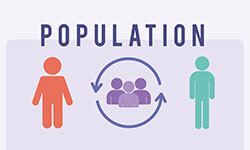
In the realm of research, the terms ‘population’ and ‘sample’ frequently surface, often leading many students to mistakenly view them as interchangeable. Yet, their distinct roles and meanings are foundational to research methodology. This article delves into the nuances that distinguish ‘population’ from ‘sample’.
Definition: Population vs. sample
A population refers to an entire group of elements or people about which you want to draw conclusions in research. On the other hand, a sample refers to a particular group of the population from which you will collect data.
Population vs. sample: Collecting data
There are many population vs. sample differences that you need to understand. Besides the definition, you may also benefit from knowing population vs. sample differences in the context of data collection.
Population vs. sample: How to collect data from a population
In research, you use a population when your research question requires you to have data from all members of a population.
Collecting data from a population is relatively straightforward if it is small, easily accessible, and cooperative. However, the challenge usually comes when dealing with larger and dispersed populations. Larger and dispersed populations make it difficult and nearly impossible to gather information from each member of the population.
It is also challenging to contact, locate, and encourage data collection participation from marginalized and low-income groups. For this reason, population counts may end up being incomplete and biased towards specific groups. Therefore, researchers lean more towards sampling for more precise inferences regarding a population and bias prevention.
Population vs. sample: How to collect data from a sample
A sample usually comes in handy in population vs. sample, when you have a large, geographically disseminated, or hard-to-contact population. In research, you can utilize data from a sample through statistical analysis to estimate or test hypotheses regarding a population.
When collecting data from a sample, it is usually ideal to use a randomly selected sample or one that is accurately representative of the population. Probability sampling techniques like simple random and stratified sampling helps you minimize sampling biases. Additionally, it helps promote internal and external validity.
Sampling bias
Something else worth mentioning in this population vs. sample article is sampling bias. Sampling bias refers to a situation where a sample does not accurately represent the qualities of the population from which it was selected. Sampling bias usually results in sample attributes being systematically different from the actual values of the population. Therefore, it creates a distorted view of the population.
Sampling bias usually occurs when you apply randomly selected samples. The sample may not represent the population in numerical contexts like the standard deviations and means. You can avoid sampling bias by selecting a representative sample.You can achieve this by increasing your sample size and diversifying it.
Population vs. sample: The differences
There is more to the population vs. sample differences in the measurement parameter and statistics context. For instance, there is a difference in the data collection for population vs. sample. Different measurements and quantities are applied in calculating data from samples and populations. Measurement parameters are used to describe an entire population. In contrast, statistics are measurements that describe a sample.
Note that you can apply hypothesis testing and estimation to approximate the likelihood of a difference between a sample statistic and a population parameter.
Knowing if the data you are using is part of a population dataset or sample dataset is also important. This will help you derive accurate information from the datasets. Choosing a sample from a population is important for the following reasons:
- It is necessary when dealing with a large and inaccessible population.
- It is more efficient for data collection.
- It is cost-effective.
- A sample is more manageable than a population.
Non-probability techniques are preferred because they are practical. Researchers can select non-probability samples for particular criteria as they are cheaper and more convenient to access.
However, as a result of non-random selection techniques, statistical inferences regarding a broader population will end up weaker compared to probability samples.
FAQs
A population refers to an entire group of elements or people about which you want to draw conclusions, while a sample is a part of the population from which you collect data.
A sample is easier for data collection because it is smaller, more practical and manageable.
Samples are used to draw conclusions about populations. Data collected from samples can help make practical inferences.
Use populations in research if the research question warrants answers from all members of a population.

